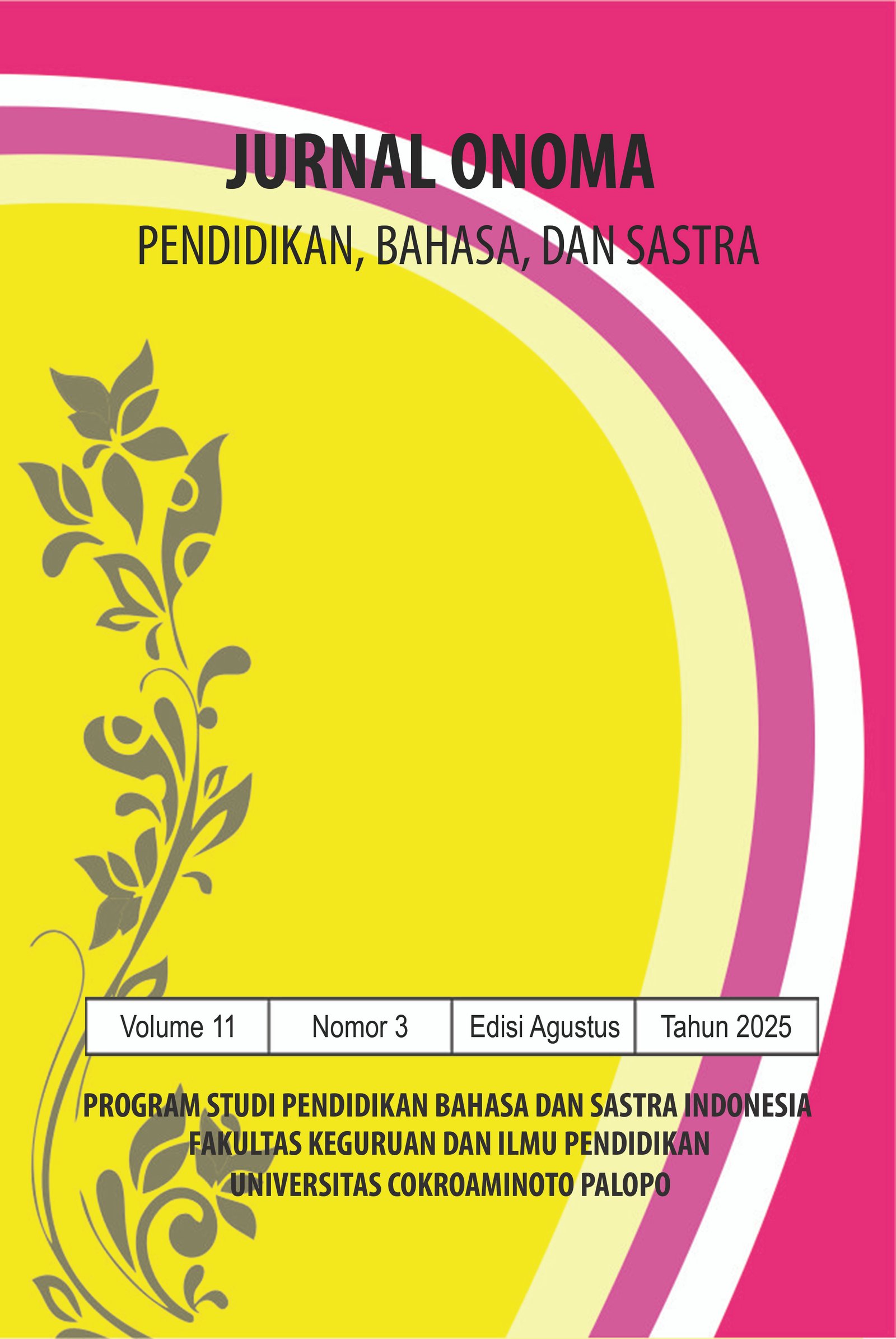Representasi Nilai Budaya Jawa dalam Buku Cerita Anak Dwibahasa: Kajian Simbolisme dan Aspek Kebahasaan pada Buku Terbitan Balai Bahasa Jawa Timur Tahun 2023
https://doi.org/10.30605/onoma.v11i3.6749
Keywords:
simbol budaya, kosakata kultural, cerita anak dwibahasa, kearifan lokal Jawa, literasi budayaAbstract
Penelitian ini bertujuan untuk menganalisis simbol kearifan lokal dan aspek kebahasaan dalam lima buku cerita anak dwibahasa terbitan Balai Bahasa Jawa Timur tahun 2023, yaitu Nonton Festival Musik Lesung, Seni Jaran Kencak, Ladu Pelangi Noni, Festival Bandeng Kawak, dan Cokelat Saka Lempung. Penelitian menggunakan metode analisis isi kualitatif dengan pendekatan teori simbolisme budaya Clifford Geertz, semiotika Roland Barthes, linguistik budaya Palmer, serta literasi dwibahasa Baker. Data berupa kutipan teks naratif, dialog, dan kosakata kultural yang dianalisis untuk mengungkap makna denotatif dan konotatif simbol, serta fungsi kosakata dalam pelestarian budaya. Hasil penelitian menunjukkan bahwa setiap cerita memuat simbol budaya yang mewakili lima dimensi kearifan lokal Jawa: tradisi agraris (lesung), seni pertunjukan (jaran kencak), kuliner keluarga (ladu), perayaan ekonomi pesisir (bandeng kawak), dan inovasi lokal (lempung & cokelat). Simbol tersebut hadir melalui narasi, tokoh, dan latar yang sarat nilai seperti gotong royong, rukun, persaudaraan, kreativitas, dan keberlanjutan. Aspek kebahasaan memperlihatkan pemakaian kosakata kultural dalam bahasa daerah dan padanannya dalam bahasa Indonesia, sehingga berfungsi ganda sebagai sarana preservasi bahasa daerah dan jembatan pemahaman lintas budaya. Penelitian ini menyimpulkan bahwa buku cerita anak dwibahasa dapat menjadi media efektif dalam internalisasi nilai budaya dan penguatan literasi multibahasa pada anak.
Downloads
References
Andriyanto, O. D., et al. (2022). Ethic Values in Modern Javanese Literature Works: Identity and Character Education in the Digital Era. Eurasian Journal of Applied Linguistics, 8(3), 106–119.
Anis, K. (2021). Budaya Jawa dalam Sastra Pesantren Hati Suhita. Kibas Cenderawasih, 1(2), 123–134.
Baker, C. (2011). Foundations of Bilingual Education and Bilingualism (5th ed.). Multilingual Matters.
Barthes, R. (2012). Mythologies (A. Lavers, Trans.). Hill and Wang.
Darni, et al. (2020). Building Student Character Through Javanese Children’s Story. ICoSSCE Proceedings. DOI: https://doi.org/10.2991/assehr.k.201201.190
Firmansyah, H. (2018). Simbol dalam kebudayaan Jawa: Analisis semiotik Clifford Geertz. Jurnal Ilmu Budaya, 6(2), 101–112.
Faruk. (2012). Pengantar Sosiologi Sastra: Dari Strukturalisme Genetik sampai Post-Modernisme. Yogyakarta: Pustaka Pelajar.
Geertz, C. (2017). The Interpretation of Cultures. Basic Books.
Kridalaksana, H. (2008). Pembentukan Kata dalam Bahasa Indonesia. Jakarta: Gramedia.
Kridalaksana, H. (2013). Kamus Linguistik (Edisi Keempat). Gramedia Pustaka Utama.
Moleong, L. J. (2018). Metodologi Penelitian Kualitatif (edisi revisi). Bandung: PT Remaja Rosdakarya.
Nurgiyantoro, B. (2005). Teori Pengkajian Fiksi. Yogyakarta: Gadjah Mada University Press.
Palmer, G. B. (2017). Linguistic Relativity and Cultural Concepts: The Sapir-Whorf Hypothesis Reexamined. Cambridge University Press.
Pertiwi, A. D. (2019). Representasi Kepercayaan Masyarakat Jawa dalam Cerita Rakyat. Bapala, 6(2), 123–135.
Putri, H. C. R. L. (2020). Representasi Pengetahuan Bahari dalam Cerita Anak. Bapala, 7(1), 45–58.
Sari, N. P., & Wulandari, D. A. (2020). Literasi berbasis budaya lokal untuk penguatan karakter anak. Jurnal Pendidikan dan Kebudayaan, 5(2), 123–133.
Sudikan, S. (2011). Sastra Anak dan Pembentukannya. Surabaya: Unesa University Press.
Sukma, E. (2023). Cerita anak dwibahasa berbasis lokal sebagai media literasi multibahasa. Bahastra: Jurnal Pendidikan Bahasa dan Sastra Indonesia, 8(1), 45–58.
Suyanto, S. (2017). Javanese Culture-Based Character Development Model for Early Childhood Education. International Journal of Academic Research in Business and Social Sciences, 7(6), 1–16.
Utami, S., Putri, D. R., & Lestari, N. D. (2020). Dwibahasa dalam pembelajaran literasi anak usia dini. Jurnal Obsesi: Jurnal Pendidikan Anak Usia Dini, 4(2), 600–611.
Wulandari, A., & Sari, M. P. (2020). Loyalty and Javanese Women in Folktales. Studia Ethnologica Croatica, 32(1), 7–24.
Zidan, M., & Genta, B. D. (2020). Representasi Simbol dalam Cerita Tanah Jawa. Dewantara: Jurnal Pendidikan, 1(2), 101–110.
Downloads
Published
How to Cite
License
Copyright (c) 2025 Zahro Rokhmawati, Aal Inderajati, Patricia Elsa Marchelia Wibiasty

This work is licensed under a Creative Commons Attribution 4.0 International License.
In submitting the manuscript to the journal, the authors certify that:
- They are authorized by their co-authors to enter into these arrangements.
- The work described has not been formally published before, except in the form of an abstract or as part of a published lecture, review, thesis, or overlay journal.
- That it is not under consideration for publication elsewhere,
- That its publication has been approved by all the author(s) and by the responsible authorities – tacitly or explicitly – of the institutes where the work has been carried out.
- They secure the right to reproduce any material that has already been published or copyrighted elsewhere.
- They agree to the following license and copyright agreement.
License and Copyright Agreement
Authors who publish with Onoma Journal: Education, Languages??, and Literature agree to the following terms:
- Authors retain copyright and grant the journal right of first publication with the work simultaneously licensed under Creative Commons Attribution License (CC BY 4.0) that allows others to share the work with an acknowledgment of the work's authorship and initial publication in this journal.
- Authors are able to enter into separate, additional contractual arrangements for the non-exclusive distribution of the journal's published version of the work (e.g., post it to an institutional repository or publish it in a book), with an acknowledgment of its initial publication in this journal.
- Authors are permitted and encouraged to post their work online (e.g., in institutional repositories or on their website) prior to and during the submission process, as it can lead to productive exchanges, as well as earlier and greater citation of published work.

















